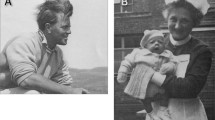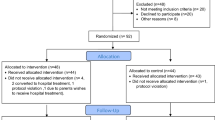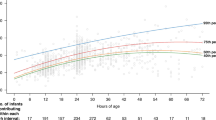Abstract
Objective:
Evaluate the efficacy of phototherapy (PT) devices and the outcomes of extremely premature infants treated with those devices.
Study Design:
This substudy of the National Institute of Child Health and Human Development Neonatal Research Network PT trial included 1404 infants treated with a single type of PT device during the first 24±12 h of treatment. The absolute (primary outcome) and relative decrease in total serum bilirubin (TSB) and other measures were evaluated. For infants treated with one PT type during the 2-week intervention period (n=1223), adjusted outcomes at discharge and 18 to 22 months corrected age were determined.
Result:
In the first 24 h, the adjusted absolute (mean (±s.d.)) and relative (%) decrease in TSB (mg dl−1) were: light-emitting diodes (LEDs) −2.2 (±3), −22%; Spotlights −1.7 (±2), −19%; Banks −1.3 (±3), −8%; Blankets −0.8 (±3), −1%; (P<0.0002). Some findings at 18 to 22 months differed between groups.
Conclusion:
LEDs achieved the greatest initial absolute reduction in TSB but were similar to Spots in the other performance measures. Long-term effects of PT devices in extremely premature infants deserve rigorous evaluation.
This is a preview of subscription content, access via your institution
Access options
Subscribe to this journal
Receive 12 print issues and online access
$259.00 per year
only $21.58 per issue
Buy this article
- Purchase on Springer Link
- Instant access to full article PDF
Prices may be subject to local taxes which are calculated during checkout

Similar content being viewed by others
References
Cremer RJ, Perryman PW, Richards DH . Influence of light on the hyperbilirubinemia of infants. Lancet 1958; 271: 1094–1097.
Vreman HJ, Wong RJ, Stevenson DK, Route RK, Reader SD, Fejer MM et al. Light-emitting diodes: a novel light source for phototherapy. Pediatr Res 1998; 44 (5): 804–809.
Seidman DS, Moise J, Ergaz Z, Laor A, Vreman HJ, Stevenson DK et al. A prospective randomized controlled study of phototherapy using blue and blue-green light-emitting devices, and conventional halogen-quartz phototherapy. J Perinatology 2003; 23: 123–127.
Tan KL . Comparison of the efficacy of fiberoptic and conventional phototherapy for neonatal hyperbilirubinemia. J Pediatr 1994; 125: 607–612.
Romagnoli C, Zecca E, Papacci P, Vento G, Girlando P, Latella C . Which phototherapy system is most effective in lowering serum bilirubin in very preterm infants? Fetal Diagn Ther 2006; 21: 204–209.
Costello SA, Nyikal J, Yu VYH, McCloud P . Biliblanket phototherapy system versus conventional phototherapy: a randomized controlled trial in preterm infants. J Paediatr Child Health 1995; 31: 11–13.
Donzelli GP, Moroni M, Rapisardi G, Agati G, Fusi F . Fiberoptic phototherapy in the management of jaundice in low birthweight infants. Acta Pediatr 1996; 85: 366–370.
Dani C, Martelli E, Reali MF, Bertini G, Panin G, Rubaltelli F . Fiberoptic and conventional phototherapy effects on the skin of premature infants. J Pediatr 2001; 138 (3): 438–440.
Van Kaam AHLC, van Beek RHT, Vergunst-van Keulen JG, van der Heijden J, Lutz-Dettinger N, Hop W et al. Fiber optic versus conventional phototherapy for hyperbilirubinemia in preterm infants. Eur J Pediatr 1998; 157: 132–137.
Bertini G, Perugi S, Elia S, Pratesi S, Dani C, Rubaltelli FF . Transepidermal water loss and cerebral hemodynamics in preterm infants: conventional versus LED phototherapy. Eur J Pediatr 2008; 167: 37–42.
Martins BMR, de Carvalho M, Moreira ME, Lopes JMA . Efficacy of new microprocessed phototherapy system with five high density light emitting diodes (Super LED). J Pediatr (Rio J) 2007; 83: 253–258.
Seidman DS, Moise J, Ergaz Z, Laor A, Vreman HJ, Stevenson DK et al. A new blue light-emitting phototherapy device: a prospective randomized controlled study. J Pediatr 2000; 136 (6): 771–774.
Maisels MJ, Kring EA, DeRidder J . Randomized controlled trial of light-emitting diode phototherapy. J Perinatol 2007; 27: 565–567.
Kaplan M, Gold V, Hammerman C, Hochman A, Goldschmidt D, Vreman HJ et al. Phototherapy and photo-oxidation in premature neonates. Biol Neonate 2005; 87: 44–50.
Morris BH, Oh W, Tyson JE, Stevenson DK, Phelps DL, O’Shea TM et al. Aggressive vs conservative phototherapy for infants with extremely low birth weight. N Engl J Med 2008; 359: 1885–1896.
Bayley N . Bayley Scales of Infant Development II. The Psychological Corporation: San Antonio, TX, 1993.
Spiegelman D, Hertzmark E . Easy SAS calculations for risk or prevalence ratios and differences. Invited Editorial Note. Am J Epidemiol 2005; 162 (3): 199–200.
Landry RJ, Scheidt PC, Hammond RW . Ambient light and phototherapy conditions of eight neonatal care units: a summary report. Pediatrics 1985; 75: 434–436.
Hart G, Cameron R . The importance of irradiance and area in neonatal phototherapy. Arch Dis Child Fetal Neonatal Ed 2005; 90: F437–F440.
Dicken P, Grant LJ, Jones S . An evaluation of the characteristics and performance of neonatal phototherapy equipment. Physiol Meas 2000; 21: 493–503.
Tayman C, Tatli MM, Aydemir S, Karadag A . Overhead is superior to underneath light-emitting diode phototherapy in the treatment of neonatal jaundice: a comparative study. J Paediatr Child Health 2010; 46: 234–237.
Rosenfeld W, Sadhev S, Brunot V, Jhaveri R, Zabaleta I, Evans HE . Phototherapy effect on the incidence of patent ductus arteriosus in premature infants: prevention with chest shielding. Pediatrics 1986; 78: 10–14.
Travadi J, Simmer K, Ramsay J, Doherty D, Hagan R . Patent ductus arteriosus in extremely preterm infants receiving phototherapy: does shielding the chest make a difference? A randomized, controlled trial. Acta Paediatr 2006; 95: 1418–1423.
Benders MJ, van Bel F, van de Bor M . Haemodynamic consequences of phototherapy in term infants. Eur J Pediatr 1999; 158: 323–328.
Benders MJ, van Bel F, van de Bor M . Cardiac output and ductal reopening during phototherapy in preterm infants. Acta Paediatr 1999; 88: 1014–1019.
Pezzati M, Biagiotti R, Vangi V, Lombardi E, Wiechmann L, Rubaltelli FF . Changes in mesenteric blood flow response to feeding: Conventional versus fiber-optic phototherapy. Pediatrics 2000; 105: 350–353.
Yao AC, Martinussen M, Johansen OJ, Brubakk AM . Phototherapy-associated changes in mesenteric blood flow response to feeding in term neonates. J Pediatr 1994; 124: 309–312.
Acknowledgements
This work was supported by grants from the National Institutes of Health and the Eunice Kennedy Shriver National Institute of Child Health and Human Development, which provided oversight for study conduct.
Author information
Authors and Affiliations
Corresponding author
Ethics declarations
Competing interests
Natus Medical loaned light-emitting diode phototherapy lights to each center. These lights were used at the discretion of the attending neonatologist in treating infants in either treatment group. The lights were returned to Natus Medical or purchased at a prorated price after the study. Natus Medical has no role in the study design, data collection, data analysis or manuscript preparation or revision.
Appendix
Appendix
Acknowledgements
The National Institutes of Health and the Eunice Kennedy Shriver National Institute of Child Health and Human Development (NICHD) provided grant support for the Neonatal Research Network's (NRN's) Phototherapy Trial (2002 to 2005).
Data collected at participating sites of the NICHD NRN were transmitted to RTI International, the data coordinating center (DCC) for the network, which stored, managed and analyzed the data for this study. On behalf of the NRN, Dr Abhik Das (DCC Principal Investigator), Dr Qing Yao, Dr Dennis Wallace and Ms Sarah Kandefer (DCC Statisticians) had full access to all the data in the study and take responsibility for the integrity of the data and accuracy of the data analysis.
We are indebted to our medical and nursing colleagues and the infants and their parents who agreed to take part in this study. The following investigators, in addition to those listed as authors, participated in this study:
NRN Steering Committee Chairs—Alan Jobe, MD PhD, University of Cincinnati (2001 to 2006); Michael S Caplan, MD, University of Chicago, Pritzker School of Medicine (2006 to present).
Alpert Medical School of Brown University and Women and Infants Hospital of Rhode Island (U10 HD27904)—Abbot R Laptook, MD; Angelita Hensman, BSN RNC; Lucy Noel RN.
Case Western Reserve University Rainbow Babies and Children's Hospital (U10 HD21364, M01 RR80)—Avroy A Fanaroff, MD; Michele C Walsh, MD MS; Deanne Wilson-Costello, MD; Nancy S Newman, RN; Bonnie S Siner, RN.
Cincinnati Children's Hospital Medical Center, University Hospital and Good Samaritan Hospital (U10 HD27853, M01 RR8084)—Edward F Donovan, MD; Kurt Schibler, MD; Jean Steichen, MD; Barb Alexander, RN; Cathy Grisby, BSN CCRC; Marcia Mersmann, RN; Holly Mincey, RN; Jody Shively, RN; Teresa Gratton, PA.
Duke University School of Medicine University Hospital, Alamance Regional Medical Center and Durham Regional Hospital (U10 HD40492, M01 RR30)—Ronald N Goldberg, MD; C Michael Cotten, MD MHS; Ricki F Goldstein, MD; Kathy J Auten, MSHS; Melody B Lohmeyer, RN MSN.
Emory University Children's Healthcare of Atlanta, Grady Memorial Hospital and Emory University Hospital Midtown (U10 HD27851, M01 RR39)—Barbara J Stoll, MD; Ira Adams-Chapman, MD; Ellen C Hale, RN BS CCRC.
Eunice Kennedy Shriver National Institute of Child Health and Human Development—Linda L Wright, MD; Elizabeth M McClure, MEd.
Indiana University Indiana University Hospital, Methodist Hospital, Riley Hospital for Children and Wishard Health Services (U10 HD27856, M01 RR750)—Brenda B Poindexter, MD MS; James A Lemons, MD; Anna M Dusick, MD; Diana D Appel, RN BSN; Dianne E Herron, RN; Lucy C Miller, RN BSN CCRC; Leslie Dawn Richard, BSN CCRC.
RTI International (U10 HD36790)—W Kenneth Poole, PhD; Betty Hastings; Elizabeth N McClure, MEd; Jamie E Newman, PhD MPH; Rebecca L Perritt, MS; Carolyn M Petrie Huitema, MS; Kristin M Zaterka-Baxter, RN BSN.
Stanford University Lucile Packard Children's Hospital (U10 HD27880, M01 RR70)—Susan R Hintz, MD MS; M Bethany Ball, BS CCRC.
University of Alabama at Birmingham Health System and Children's Hospital of Alabama (U10 HD34216, M01 RR32)—Waldemar A Carlo, MD; Namasivayam Ambalavanan, MD; Myriam Peralta-Carcelen, MD MPH; Monica V Collins, RN BSN MaEd; Shirley S Cosby, RN BSN; Vivien A Phillips, RN BSN.
University of California—San Diego Medical Center and Sharp Mary Birch Hospital for Women (U10 HD40461)—Neil N Finer, MD; Yvonne E Vaucher, MD MPH; Maynard R Rasmussen MD; David Kaegi, MD; Kathy Arnell, RNC; Clarence Demetrio, RN; Martha G Fuller, RN MSN; Chris Henderson, RCP CRTT; Wade Rich, BSHS RRT.
University of Miami Holtz Children's Hospital (U10 HD21397, M01 RR16587)—Charles R Bauer, MD; Shahnaz Duara, MD; Silvia Hiriart-Fajardo, MD; Ruth Everett-Thomas, RN BSN; Amy Mur Worth, RN MS; Silvia Frade Eguaras, MS.
University of Rochester Medical Center Golisano Children's Hospital (U10 HD40521, M01 RR44)—Ronnie Guillet, MD PhD; Gary J Myers, MD; Linda J Reubens, RN CCRC; Diane Hust, MS RN CS; Rosemary L Jensen; Erica Burnell, RN.
University of Texas Southwestern Medical Center at Dallas Parkland Health and Hospital System and Children's Medical Center Dallas (U10 HD40689, M01 RR633)—Walid A Salhab, MD; Pablo J Sanchez, MD; Charles R Rosenfeld, MD; Roy J Heyne, MD; Jackie Hickman, RN; Gay Hensley, RN; Nancy A Miller, RN; Janet Morgan, RN.
University of Texas Health Science Center at Houston Medical School, Children's Memorial Hermann Hospital and Lyndon Baines Johnson General Hospital/Harris County Hospital District.
(U10 HD21373, KL2 RR24149, UL1 RR24148)—Kathleen Kennedy, MD MPH; Pamela J Bradt, MD MPH; Patricia W Evans, MD; Laura L Whiteley, MD; Esther G Akpa, RN BSN; Patty A Cluff, RN; Anna E Lis, RN BSN; Claudia I Franco, RNC MSN; Maegan Currence, RN; Nora I. Alaniz, BS; Patti L Pierce Tate, RCP; Sharon L Wright, MT(ASCP).
Wake Forest University Baptist Medical Center, Brenner Children's Hospital, and Forsyth Medical Center (U10 HD40498, M01 RR7122)—Lisa K Washburn, MD; Nancy J Peters, RN CCRP; Barbara G Jackson, RN BSN.
Wayne State University Hutzel Women's Hospital and Children's Hospital of Michigan (U10 HD21385)—Seetha Shankaran, MD; Yvette Johnson, MD; Athina Pappas, MD; Rebecca Bara, RN BSN; Geraldine Muran, RN BSN; Deborah Kennedy, RN BSN.
Yale University Yale-New Haven Children's Hospital (U10 HD27871, M01 RR6022)—Richard A. Ehrenkranz, MD; Patricia Gettner, RN; Harris C Jacobs, MD; Christine Butler, MD; Patricia Cervone, RN; Monica Konstantino, RN BSN; Elaine Romano, MSN.
Rights and permissions
About this article
Cite this article
Morris, B., Tyson, J., Stevenson, D. et al. Efficacy of phototherapy devices and outcomes among extremely low birth weight infants: multi-center observational study. J Perinatol 33, 126–133 (2013). https://doi.org/10.1038/jp.2012.39
Received:
Revised:
Accepted:
Published:
Issue Date:
DOI: https://doi.org/10.1038/jp.2012.39
Keywords
This article is cited by
-
New high intensity fibreoptic phototherapy devices in healthy newborns: a single pad wrapped around the neonate body in comparison with a double pad device
Italian Journal of Pediatrics (2019)
-
The effect of hematocrit on the efficacy of phototherapy for neonatal jaundice
Pediatric Research (2013)



